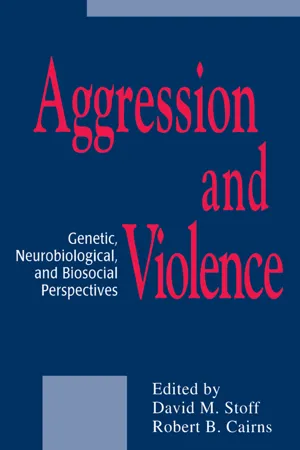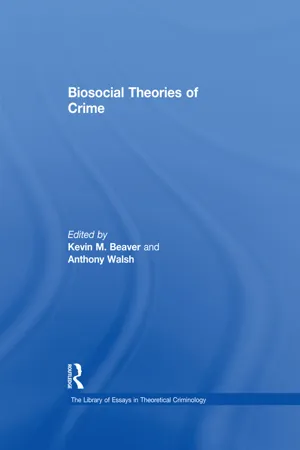Psychology
Genetic Origins of Aggression
The genetic origins of aggression refer to the influence of genetic factors on the development of aggressive behavior in individuals. Research in this area explores how genetic variations may contribute to the predisposition for aggressive tendencies, and how these genetic influences interact with environmental factors to shape an individual's propensity for aggression.
Written by Perlego with AI-assistance
Related key terms
7 Key excerpts on "Genetic Origins of Aggression"
- eBook - ePub
The Social Psychology of Aggression
3rd Edition
- Barbara Krahé(Author)
- 2020(Publication Date)
- Routledge(Publisher)
With regard to the question of whether or not aggression is an inevitable part of human nature and individual character, research showing the impact of genetic factors has sometimes been construed as suggesting a deterministic, and thus pessimistic, view – if individuals carry the aggressive genes, they will grow up to be aggressive. However, such a view is rejected by behaviour geneticists. They stress that individuals’ genetic make-up may predispose them towards becoming an aggressive person, but environmental factors play a crucial role in determining whether or not that predisposition will actually be expressed in aggressive behaviour. As noted by Van Goozen, Fairchild, Snoek, and Harold (2007), a genetic disposition towards aggressive behaviour may become manifested in behaviour in a negative family environment, or it may be suppressed in a positive environment. As children inherit the genetic disposition towards aggression from their parents, they are likely to grow up in a more aggression-prone family environment (Moffitt, 1993). To complicate matters further, children with a genetic disposition towards aggression may elicit negative responses from their social environment through their aggressive behaviour, also pointing to the interactive influences of nature and nurture.The critical role of environmental factors is also demonstrated by evidence from the field of epigenetics . This research has shown that adverse experiences affecting individuals at sensitive periods of life, especially in prenatal development and early infancy, may trigger changes in the function of genes that lead to cognitive and emotional deficits involved in aggressive behaviour (Palumbo, Mariotti, Iofrida, & Pellegrini, 2018; Waltes et al., 2016). These findings show that genetic (inherited) and environmental (acquired) factors mutually influence each other, which may explain why individual differences in aggressive behaviour are highly stable over time. We will return to the issue of stability in more detail in Chapter 4 .epigenetics: field of study showing that adverse experiences may change a person’s genes related to aggressive behaviour.H ormones and aggression
hormones: higher levels of testosterone and lower levels of cortisol have been linked to aggression, but they need to be considered in combination with environmental influences.Another line of biological research on aggression is concerned with the role of hormonal and other physiological processes in explaining variations in aggressive behaviour (Archer & Carré, 2017; Van Goozen, 2005). An obvious candidate for examination is the male sex hormone testosterone, both to account for individual differences among men in their aggressive tendencies, and to explain the widely demonstrated gender differences in physical aggression (see Chapter 4 - eBook - ePub
Social Psychology in Christian Perspective
Exploring the Human Condition
- Angela M. Sabates(Author)
- 2012(Publication Date)
- IVP Academic(Publisher)
Parens (2004), for example, notes some significant obstacles for behavioral genetic research. First, suppose researchers find that identical twins (exact genetic match) are more similar on some trait than are fraternal twins. In this case we might have a greater confidence that genes are involved, but these findings do not yet reveal anything regarding which genes are involved and in what ways. Second, suppose a researcher were interested in evaluating the relative effects of genes and environment and compared identical twins raised together with those raised apart for a particular aspect of aggression. The results often will not be informative since, as most of the research suggests, identical twins are likely to be adopted into quite similar environments, which negates the environmental factor. Thus, it appears that with respect to genetic influences on aggressive behavior, we are nowhere near finding a “criminal gene.” Instead, it is more accurate to suggest that some individuals appear to be especially vulnerable to the ill effects of negative environments and may be more inclined toward antisocial behavior, including aggression. The exact mechanisms that explain the complex interplay between genetic/physiological and environmental influences are far from being determined. Additionally, the research to date does not support the notion that people with “vulnerable genes” have no choice regarding aggression. Indeed, as Parens (2004) notes, to say that something is influenced by genetics is not the same thing as saying that it is unchangeable. A brief comment on biological explanations of aggression. As noted in the literature just discussed, there have been many advances in isolating specific brain structures and neurochemical processes, as well as possible genetic contributions to aggressive behavior. Several words of caution are needed, though. Keep in mind that much of this research has conflicting results - eBook - ePub
Aggression and Violence
Genetic, Neurobiological, and Biosocial Perspectives
- David M. Stoff, Robert B. Cairns(Authors)
- 2014(Publication Date)
- Psychology Press(Publisher)
The results of recent programs of selection for aggressive behavior challenge commonly accepted assumptions on the relations between genes, development, neurobiology, and social behaviors. In their place, a new framework has emerged in which the analysis of the multiple factors cannot be divorced from their proximal controls, developmental functions, and experiential contexts. This research has provided, as a byproduct, fresh information on related problems, including the heritability of sex differences, the age- and context-relativity of genetic effects, and the reversibility of social patterns. Rather than complicating the picture, an integrated view of aggressive behaviors in terms of development, social learning, neurobiology, and intergenerational transfer now appears to make the phenomena more accessible to general biobehavioral theory. In this chapter, we summarize some of the findings that have been obtained on these matters and discuss their implications for social development and the consolidation of aggressive behaviors. In closing, we offer some comments on the special properties of behavior–especially social behaviors–in organismic adaptation.Genetic Background and Aggressive Behavior in Mice
The first modern research effort to selectively breed mice for aggressive behavior was initiated by Kirsti Lagerspetz in the early 1960s. Lagerspetz began with the establishment of aggressive lines of mice through selective breeding, then analyzed for behavioral and physiological mediators. The detailed analysis of between-line behavioral similarities and differences has proceeded over the past 30 years in the Turku laboratory (e.g., Lagerspetz, 1964 ; Lagerspetz & Lagerspetz, 1975 ; Sandnabba, Lagerspetz, & Jensen, 1994 ).Another selective breeding program was initiated in the early 1970s in the United States and focused initially on the social interactional and developmental controls of aggression (e.g., Cairns, 1973 , 1976 ; Cairns, Gariépy, & Hood, 1990 ; Gariépy, Hood, & Cairns, 1988 - eBook - ePub
- KevinM. Beaver(Author)
- 2017(Publication Date)
- Routledge(Publisher)
Table 1 summarizes the text. The research designs covered here are not intended to be exhaustive but are intended to illustrate what kinds of studies can be done using the logic of behavioral-genetic methods.Question 1: Is Children’s Aggression Wholly Accounted for by Genetic Factors, or Does It Have Nongenetic Causes as Well?
More than 100 studies have addressed the question of genetic influence on antisocial behavior (Moffitt, in press), and metaanalyses conclude that genes influence 40% to 50% of population variation in antisocial behavior (Miles & Carey, 1997; Rhee & Waldman, 2002). This research unequivocally proves that environmental influences account for variation. This fact constitutes a remarkable contribution to the understanding of causation (Plomin, 1994). In addition, it is recognized that the heritability coefficient indexes not only the direct effects of genes but also the effects of interactions between genes and family-wide environments (Boomsma & Martin, 2002; Rutter & Silberg, 2002). In such interactions, the effect of an environmental risk may be even larger than previously reported among the subgroup of individuals having a vulnerable genotype. This is the case for antisocial behaviors.One useful feature of behavioral-genetic research designs is that they offer two powerful methods for documenting the importance of environmental effects (Plomin, DeFries, McClearn, & McGuffin, 2001). One of these methods of detecting environmental influence tests whether any of the family members in a study sample are more similar than can be explained by the proportion of genes they share. For instance, monozygotic (MZ) twins’ genetic similarity is twice that of dizygotic (DZ) twins and, therefore, if nothing but genes influenced antisocial behavior, MZ twins’ behavior ought to be at least twice as similar as that of DZ twins. If that is not the case, then it can be assumed that something environmental has influenced the twins and enhanced their similarity. For almost all human behavioral traits studied thus far, environmental factors shared by family members (variously labeled the “family-wide,” “common,” or “shared” environment) have not been found to make family members similar (Rowe, 1994). Antisocial behavior is a marked exception. A comparison of shared environment effects across 10 psychiatric disorders revealed that such effects were stronger for antisocial personality and conduct disorder than for affective, anxiety, or substance disorders (Ken-dler, Prescott, Myers, & Neale, 2003). - eBook - ePub
Aggression and Violence
A Social Psychological Perspective
- Brad J. Bushman(Author)
- 2016(Publication Date)
- Routledge(Publisher)
Part I Understanding the Roots of Aggression and Violence in HumansPassage contains an image
1 An Integrative Theoretical Understanding of Aggression
L. Rowell HuesmannIn this chapter I lay out the most important key principles for understanding the occurrence of aggressive behavior. These are principles that have emerged out of many decades of research on aggression but also draw on key findings from social, cognitive, and developmental psychology. Aggressive behavior is a social behavior, is influenced by peoples’ cognitive processing, and changes over the developmental life course.In the context of this chapter, aggressive behavior is any behavior intended to injure or irritate another person (Berkowitz, 1974, 1993; Eron et al., 1972). Psychologists have usually distinguished between the kind of aggressive behavior that is directed at the goal of obtaining a tangible reward for the aggressor (instrumental or proactive aggression) and the kind of aggressive behavior that is simply intended to hurt someone else (at different times denoted hostile, angry, emotional, or reactive aggression) (Berkowitz, 1993; Dodge & Coie, 1987, Feshbach, 1964). Nevertheless, an examination of the underlying cognitive processes involved (e.g., Dodge & Coie, 1987) has led to a realization that many of the same mechanisms are involved in both types of aggression (Bushman & Anderson, 2001); so many of the principles I describe in this chapter apply to both types. Finally, violent behavior is defined simply as an extreme form of aggressive behavior in which the target of the behavior is actually physically harmed, e.g., hit, punched, choked, beaten, bludgeoned, stabbed, shot.Four Important Principles about the Occurrence of Aggressive Behavior
First - eBook - ePub
- G Neil Martin, G Neil Martin(Authors)
- 2015(Publication Date)
- Routledge(Publisher)
Biological psychology has studied a number of the chemical and neural bases of aggression, especially the unprovoked type because this is socially the most vexed kind (we may disagree with wars but the democracies that wage them usually have some purpose, even if one disagrees with that purpose). Unprovoked aggression is anti-social, dangerous and damaging to the quality of our lives. If there is a biological basis to this aggression, we may be in a better position to understand it and, possibly, limit it. Biological explanations are not the only explanations for violent behaviour, however. Social psychology, while recognising our potentially innate disposition to aggress, has proposed social and/or environmental interpretations of the causes that encourage (as well as inhibit) violent behaviour, from the frustration of our goals, to the learning of aggressive behaviour from others (Bandura, 1977), to the potentiation of aggression in people already having a tendency to respond to events aggressively. The focus in the next sections, however, will be limited to the evident biological correlates of (principally) human violence. Studies of non-human species are also important and these will be used to speculate on their importance to human species.According to Linnoila and Charney (1999), aggression can be characterised in three ways: competitive, premeditated and impulsive. Competitive aggression is socially sanctioned where violence occurs in acceptable circumstances. Sport is an obvious example. The primary aim of rugby is not to aggress but it is an unavoidable consequence of playing the game. Boxing and wrestling, however, are (at least to some) socially acceptable sports in which aggression is central. Few studies have explored the biological correlates of competitive aggression, but there are studies that do show hormonal changes in people who observe competitive sports (and we'll return to these in a later section).Premeditated physical aggression refers to acts that are not impulsive: the behaviour of the police, the armed forces and certain criminals can be described as premeditated in this sense.The most common form of violence, in terms of frequency, is impulsive aggression. These acts of physical violence are invariably associated with alcohol and other substance use and are usually inexplicable to the observer. The acts are usually repeated and are unprovoked; even when they are provoked, the retribution is dispropportionate to the initial provocation. The victim may be unknown to the perpetrator and, if the violence involves a weapon, the consequences can be fatal. - eBook - ePub
Control of Aggression
Implications from Basic Research
- Stanton Wheeler(Author)
- 2017(Publication Date)
- Routledge(Publisher)
3Genetics and Mouse Aggression G. E. Mcclearn and J. C. DefriesGerald McClearn completed his Ph.D. degree at the University of Wisconsin. His experience includes fellowships at the Institute of Animal Genetics in Edinburgh, Scotland and Gauthen Laboratory in London. Presently Dr. McClearn is the director of the Institute for Behavioral Genetics at the University of Colorado. His research has covered the broad spectrum of behavior genetics.Professor John C. DeFries received his bachelor's degree in agriculture from the University of Illinois. Subsequently, he completed both the M.A. and Ph.D. in quantitative genetics at the University of Illinois. After completing the Ph.D., he remained on the faculty of the University of Illinois until 1967, when he joined the faculty of the University of Colorado. Dr. DeFries is currently professor in the Institute of Behavioral Genetics, and a lecturer in the Department of Biology and the Department of Psychology at the University of Colorado. In addition, he has been a research fellow at the University of California, Berkeley, and visiting professor of genetics at the University of Hawaii. In 1969 Professor DeFries was invited as a visiting lecturer to the N.A.T.O. Advanced Studies Institute in Psycho genetics at the University of Birmingham, England. He is currently editor of Behavior Genetics.The causes of aggression are currently being examined with an unprecedented vigor, impelled by the urgency of many of our contemporary social problems, The social, behavioral, and biological sciences are all concerned with this evaluation, and the data and concepts from their respective domains are being invoked in the attempt to understand the causes of violence. Unfortunately, a residual from the old nature-nurture controversy impedes the exchange of ideas and concepts among these various disciplines. There often appears to be among social scientists an implicit (and sometimes explicit) belief that any point conceded to biological factors is one point less for social and environmental factors. This attitude reflects a dichotomous view of behavioral determination which is as unwarranted as it is widespread. There is no merit in the old proposition that pits “nature” against “nurture” as logically incompatible forces. On the contrary, genes and environmental forces interact from the moment of conception. Thus, the effects of a given genetic difference between people may be greater or less depending upon the environmental circumstances in which they reside. Similarly, the impact of an environmental agent depends upon the hereditary nature of the individual upon whom it impinges.
Learn about this page
Index pages curate the most relevant extracts from our library of academic textbooks. They’ve been created using an in-house natural language model (NLM), each adding context and meaning to key research topics.






